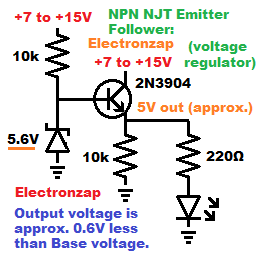Table of Contents
An NPN BJT wired as an Emitter follower, which has a fixed voltage at the Base thanks to a zener diode, acts as a voltage regulator. The Emitter voltage will be 0.6V less than the voltage at the Base. Using a 5.6V zener diode, you can hold approx. 5V across a load between the Emitter and ground.

- The LED and it’s protective resistor will have about 5V across it even though the supply voltage is higher.
- Zener diode holds approx. 5.6V at the Base of the 2N3904 NPN BJT. About 0.6V will be dropped from that 5.6V when the Base current flows to the Emitter, which is why the Emitter will only be at 5V.
- The small amount of Base current lets the Collector pass enough current from the supply to maintain the Base voltage minus approx. 0.6V at the Emitter. Since the Base delivers hardly any current because it lets the Collector pass a lot more to power the load, the Base maintains it’s voltage, and thus the Emitter voltage.
- Without collector current, the Base current won’t be strong enough to power the load at all. The collector has to pass enough current to make sure the Base current only has to maintain 0.6V across the Base and Emitter.
- The extra supply voltage will be across the BJT Collector to Emitter, and the pull up resistor at the Base.
- Supply voltage should be at least about 2V higher than what the output will be. If the supply voltage is too high, then the transistor will overheat. Limit the voltage and current to no more than the BJT wattage rating, and try to keep it below half the BJT wattage rating to be safe.
- A 10k resistor is commonly added parallel to the load. Some loads will throw off the voltage for some reason or another, but having a 10k resistor from Emitter to ground helps maintain the Emitter voltage to what it should be.
I like browsing example circuits in these books. Clicking an affiliate link before making any purchase supports this channel.
Good topics to check out next:
To support this site, check out the following links:
- Check out my YouTube videos! https://www.youtube.com/c/Electronzap/videos
- Products I used in my videos or otherwise think look like a good buy. As an Amazon associate, I earn from qualifying purchases. https://www.amazon.com/shop/electronzapdotcom
- Information on this site is not guaranteed to be accurate. Always consult the manufacturer info/datasheet of parts you use. Research the proper safety precautions for everything you do.
- Electronzap is a participant in the Amazon Services LLC Associates Program, an affiliate advertising program designed to provide a means for sites to earn advertising fees by advertising and linking to amazon.com.